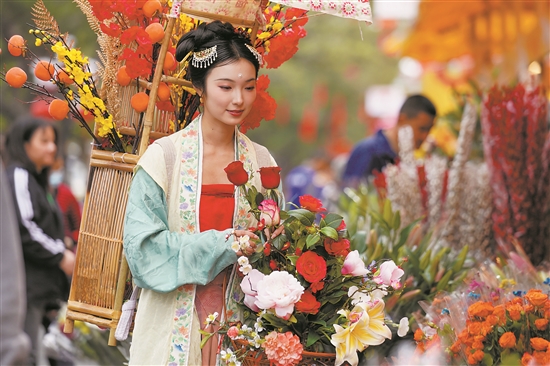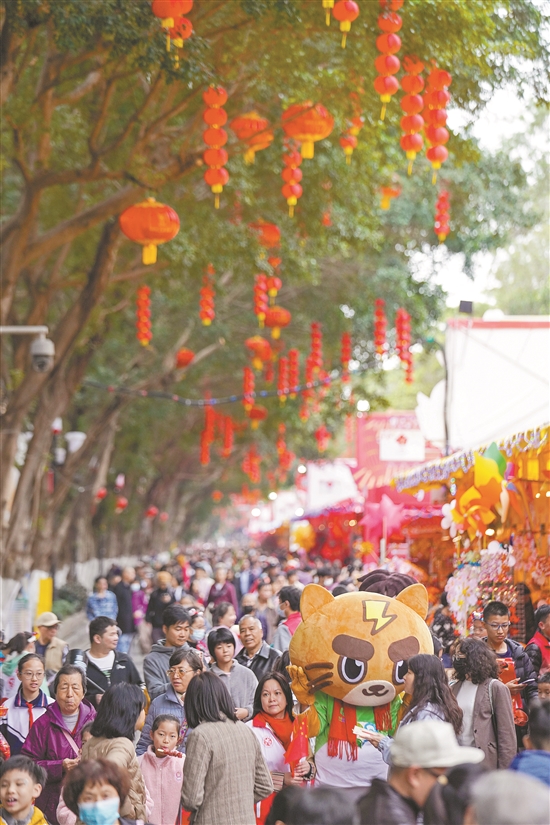

"Why not take a walk along the Flower Street?" At 10 am on February 6th, the Chinese New Year Flower Market in Haizhu District opened to the public. It will be held until February 10th, with 410 stalls set up on-site.
As you step into the main venue of the Haizhu Flower Market on Binjiang Road, a magnificent archway amidst vivid elements of Cantonese culture and the festive atmosphere will catch your eyes. On stage, ancient melodies fill the air as classical dances extol the good times, while trendy street dance electrifies the audience. Below the stage, families stroll the streets together, chatting warmly with the flower vendors. Genuine smiles on everyone'sfaceare the best "passport" for this splendid flower market.

This year, the Haizhu Flower Market offers a wide variety of flowers at affordable prices, such as peach blossoms, peonies, lilies, and orchids. When you approach the flower stalls enveloped by the fragrant scent, your eyes will be delighted with the abundance of choices. This year, there are also special stalls for ornamental fish, handicrafts, and local snacks, catering to the needs for Chinese New Year's goodspurchasing.Multiple stalls are displaying red envelopes and ornaments with motifs of the Chinese zodiac dragon, as well as various handmade crafts incorporating Guangdong embroidery and other intangible cultural heritage techniques, adding a strong festive ambiance.
Strolling along Flower Street while enjoying the river views is a romantic activity revealing the charm of Haizhu as the "millennium flower land." According to historical records, the tradition of buying flowers during the Chinese New Year in Guangzhou dates back to the Southern Han period over a thousand years ago. At that time, Zhuangtou Village in Haizhu was famous for growing royal jasmines. Villagers who relied on flowers for their livelihood managed to turn the village into a "flower field," creating the earliest Flower Market in Guangzhou. Today, the Haizhu Flower Market has become the only riverside flower market in Guangzhou.
The archway at the Binjiang Flower Market, which serves as the main venue, combines Cantonese architectural culture and Haizhu characteristics. Below the dragon pearl is a flower-shaped logo depicting the imagery of royal jasmines and lanterns, paying tribute to the thousand-year history and culture of Haizhu, the flower land. In addition, twenty renowned Lingnan traditional Chinese painting artists have created a scroll entitled "Haizhu, the Flourishing Millennium Flower Land," demonstrating the history of flowers and the market in Haizhu District.
广州海珠迎春花市开放,花街江景两相宜
“行花街啦!”2月6日上午10时,海珠区迎春花市正式开放。花市举办时间为2月6日至10日,现场设置410个档位。
走进海珠花市滨江路主会场,气势恢宏的主牌楼映入眼帘,广府底蕴和海珠年味的元素活灵活现。台上,古曲古韵歌舞升平,潮酷街舞嗨翻全场;台下,市民街坊全家出动,花档摊主热情揽客,每个人发自内心的“笑脸”,是这场盛大花市的最佳“通行证”。
今年海珠花市花卉品种多且价格实惠。桃花、牡丹、吊钟、百合、兰花……来到鲜花摊位前,琳琅满目,香气扑鼻。此外,今年花市特别设置了观赏鱼、手工艺品、风味小吃等摊位,满足更多市民游客置办年货、装饰居室的需要。不少档位摆出了龙年元素的利是封、挂件以及带有生肖龙图案的各类手工制品,结合广绣技艺等非遗技艺,增添浓浓年味。
逛花街、赏江景,蕴藏海珠“千年花洲”的浪漫。史料记载,广州新年买花的传统最早可以追溯到一千多年前的南汉时期。海珠区庄头村以种植素馨花闻名,靠花谋生的村民将村落打造成“花田”,形成广州最早的花市。如今,海珠花市成为广州唯一的临江花市。
在主会场滨江花市,牌楼融合广府建筑文化与海珠特色,龙珠下方则呈现素馨花瓣、红灯笼意象的花字形logo,致敬海珠花洲千年悠久历史文化。此外,二十位岭南国画名家以《千年花洲·欣欣海珠》为主题创作了一幅跨越千年时空,还原海珠花史、花市的国画长卷。
文|羊城晚报记者 卢佳圳 实习生 樊雨晴
图|羊城晚报记者 宋金峪
翻译|洪婷
-
First batch of Chinese New Year dishes made in Guangdong sold out in New Zealand
2024-02-07 23:33:00 -
Lighting the wok for nostalgic Chinese New Year snacks
2024-02-06 22:48:28 -
Video:The strategic image of Cantonese merchant in the Qing dynasty|Master’s talk - Cantonese Collections
2024-02-06 22:46:31 -
Video|Celebrate New Year of the Dragon with Chinese students abroad
2024-02-06 22:46:34






